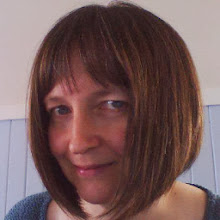
Scaffolding went up around our building about two weeks ago, but we've only seen the workers for a few odd days. It's a bit disconcerting to live in an apartment with no curtains on the street-side windows and men repairing stucco outside on the fourth floor at 8:30 a.m. It reminds me of the time we built the addition on the house at Tchesinkut Lake. Sleeping on a mattress in the middle of the living room, we often had to scramble to get dressed at 7:00 a.m. when Fred Carpenter, the carpenter, and several of his eight sons cheerfully arrived to start their day. But I digress.... For as long as we've known it, our Strasbourg apartment has been a washed-out orange colour, but apparently it's destined to be bright yellow.
Europeans aren't as reticent as we North Americans about painting buildings with bright hues.
 And just like a little kid, I'm always thrilled by the jeweled colours of the houses that we have seen as we have travelled around Europe, especially France and Germany. Last week I was in building-picture-taking heaven when we visited Colmar, a small city south of Strasbourg about 30 minutes by train.
And just like a little kid, I'm always thrilled by the jeweled colours of the houses that we have seen as we have travelled around Europe, especially France and Germany. Last week I was in building-picture-taking heaven when we visited Colmar, a small city south of Strasbourg about 30 minutes by train.Mark had gone to the train station the day before intending to buy tickets for St. Dié, a village in the Vosges mountains. However, no one at the train station really knew St. Dié, and everyone there agreed that Colmar was a very good place to visit, so Mark caved in to his insecurities about St. Dié (does it have two train stations or one? and what if we end up getting dumped off the train in the middle of nowhere?) and came home with tickets for Colmar. (But we're still going to do St. Dié!)
Initially somewhat disappointed, we were happily surprised with Colmar and its tourist experience.
 The Alsatian half-timbered houses that we see in Petite France in Strasbourg are numerous in Colmar, and even more brightly coloured. Most of their important buildings are signed in French, German, and English, which always makes it more meaningful (literally!) for us. (Even though our French is getting better, it's amazing what little nuances -- and sometimes big meanings! -- you miss when you're reading something that's not in your first language). And in Colmar, unlike most of the other trilingual signage we have seen, the English and German sections were equally as long as the French, signifying that we were getting the full story and not just a brief summary.
The Alsatian half-timbered houses that we see in Petite France in Strasbourg are numerous in Colmar, and even more brightly coloured. Most of their important buildings are signed in French, German, and English, which always makes it more meaningful (literally!) for us. (Even though our French is getting better, it's amazing what little nuances -- and sometimes big meanings! -- you miss when you're reading something that's not in your first language). And in Colmar, unlike most of the other trilingual signage we have seen, the English and German sections were equally as long as the French, signifying that we were getting the full story and not just a brief summary.At the beginning of our visit, Mark chuckled when he got off the train because he'd overheard a German couple talk about Colmar's wonderful water tower.
 At the end of the visit, and on our way back to catch the train home, we made a slight detour and found out that the water tower is indeed impressive. The Germans probably knew about it because the tower was built in 1870 during a time that Germany had annexed Alsace. Although old, it was in use as late as 1984. Now I think it just sits there and looks impressive, but not to the kids who, after three hours of wandering around, were tired and just wanted to get back home.
At the end of the visit, and on our way back to catch the train home, we made a slight detour and found out that the water tower is indeed impressive. The Germans probably knew about it because the tower was built in 1870 during a time that Germany had annexed Alsace. Although old, it was in use as late as 1984. Now I think it just sits there and looks impressive, but not to the kids who, after three hours of wandering around, were tired and just wanted to get back home.On the way back home we snagged our own compartment in the train, which made for a very relaxing trip back. I had to shake myself out of picture-taking mode, so I tried not to look out the window at all of the colourful houses flashing by.
Even though the trip to Colmar provided some good examples of Alsatian design, I don't think I'll stop taking pictures of the buildings here.
 After almost six months of living in Strasbourg, I still marvel at the architecture and decoration of the old buildings, which causes me to pause and snap pictures on almost every walk. My family gets tired of waiting for me, but they always appreciate the "slide show" when we get back home.
After almost six months of living in Strasbourg, I still marvel at the architecture and decoration of the old buildings, which causes me to pause and snap pictures on almost every walk. My family gets tired of waiting for me, but they always appreciate the "slide show" when we get back home.More pictures at Flickr: http://www.flickr.com/photos/christina-t/
Read the kids' blog: http://www.viewegkids.blogspot.com/
Contact us: christinateskey @ yahoo.ca or mvieweg @ gmail.com

No comments:
Post a Comment